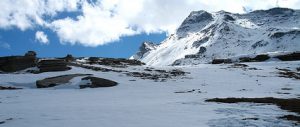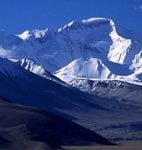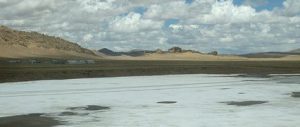In December 1997, when world leaders assembled in Kyoto to put in place the first treaty to address climate change, Chewang Norphel had already pioneered an adaptive solution to water worries in the high-altitude deserts of Ladakh, northwest India.
This cold, scenic desert has for many years suffered the impacts of climate change. “Glaciers have been receding rapidly for the last four-to-five decades,” said Norphel, 74. Eighty percent of the farmers in Leh district, he said, depend on glacier-melt to irrigate agricultural land and grow vegetables, barley and wheat. “This creates a lot of problems for the farmers, less snowfall and irregular ice-melt is now becoming a permanent feature,” he added.
The Indus River flows hundreds of metres beneath the farmlands of Leh – too far below for the farmers to rely on its water. “It is so low that we are not in a position to build lift stations for irrigating our farmlands,” said Norphel. Moreover, there are many limitations on farming in a cold desert like Ladakh. “Only one crop is grown a year here, for which the sowing period starts in April-May – a time when water is not available in a great enough quantity,” said Norphel.
Norphel said that every farmer wonders if there is a way to start farming at an earlier time. “I vividly remember that when I was a child, glaciers from lower ranges used to supply water as early as in April, but now all those glaciers have vanished,” recalled Norphel.
Call it a quirk of fate, but Norphel stumbled by chance upon the phenomenon that is now increasingly seen as a solution for fixing irrigation problems in the arid region. “People in cold regions leave the taps in bathrooms half-running during the night in winter, in order to avoid water freezing in the supply-pipe from the tank,” said Norphel, a civil engineer who used to work in a government department. “One morning, I realised that this water was freezing in our garden nearby. It struck me that small, artificial glaciers could be shaped in the same manner.”
“Since I had travelled to most of the places in the region during my service period until 1986, I was aware of the topography of the entire region,” he said. “I thought the shaded areas in the lower ranges could be utilised for this purpose.” Thus began a new incarnation in the engineer’s career: he became the “iceman”, as he is now popularly known.
Norphel created his first artificial glacier in Phuktse Phu village in 1987, simply by diverting a watercourse, reducing its volume and velocity, and then making it accumulate in the shadow of a hill. “The shadowy area for the artificial glacier is a must,” said Norphel. “It is a very simple method which can be followed by a layman. It doesn’t cost much.”
Norphel has already created around eight artificial glaciers, which cater to the irrigation needs of farmers in various hamlets, and he is now busy making three more glaciers near Stakmo village. “It will cost me around one million Indian rupees [US$21,460, or 149,000 yuan] to create these three glaciers, which would together produce two million cubic feet [56,634 cubic metres] of ice,” he said. Many of the artificial glaciers, such as those in Omla, Stoke and Stakmo, were damaged by floods in 2006 and are now being repaired.
The Indian Army, under its Operation Sadbhavna programme, is funding the repair of the artificial glaciers at Stakmo, while limited funding for other artificial glaciers has come from the government’s watershed development programmes. India’s deparment of science and technology has also been financing the repairs.
According to Norphel and other experts in Leh, the artificial glaciers are much to the satisfaction of farmers. The artificial glaciers are also seen as a solution for other problems: helping to recharge groundwater and rejuvenate springs; enabling farmers to harvest two crops per year; developing pastures for cattle-rearing; and reducing water-sharing disputes between farmers.
The creation of artificial glaciers could be a significant technique, given studies that show a good percentage of glaciers in the Himalayas are receding at a rapid rate. According to a report from the International Centre for Integrated Mountain Development (ICIMOD), 35% of the glaciers in the region will disappear in the next 20 years even as temperatures across the Himalayas would rise by 2.5 degrees Celsius by 2050. In a warming region, the iceman’s invention may be a useful adaptive tool.
Athar Parvaiz is an environmental journalist based in Kashmir
Homepage image: Chewang Norphel in Ladakh, photo by Athar Parvaiz



